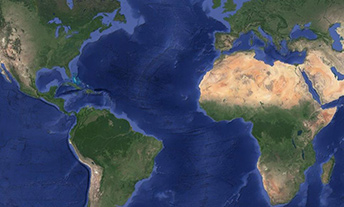
Ali Omar
Acting Deputy Director for Science at NASA Langley Research Center
Contents
- Education
- What first sparked your interest in space and science?
- How did you end up working in the space program?
- Tell us about your job. What do you do?
- What’s one piece of advice you would give others interested in a similar career?
- What has been your biggest challenge, professionally or personally, and how did you overcome it?
- Who inspires you?
- What have been some of your favorite projects to work on?
- What are some fun facts about yourself?
- What is your favorite space image and why?
- Where are they from?
Education
High School: St. Mary’s College Kisubi, Uganda
College: Saint Louis University | Aerospace Engineering (BS, MS)
College: University of Illinois, Urbana (MS, Ph.D.) | Civil and Environmental Engineering
What first sparked your interest in space and science?
My high school (St. Mary’s College Kisubi, Uganda) was only 6 miles (about 10 kilometers) from the main international airport in Uganda, and we used to go watch airplanes take off and land. I became interested in aviation in the eighth grade, and this interest continued throughout high school.
After high school, I went to aircraft mechanics school in Uganda and earned my Federal Aviation Administration (FAA) certified mechanic’s license, and this led me to aerospace engineering undergraduate and master’s degrees. I specialized in combustion, and during one of my courses on emissions from aircraft engines, I became interested in the emissions of fossil fuel combustion products and the effects on the environment. This led me to studies of particulate pollution control methods and monitoring using in-situ and remote-sensing methods.
“Science is inherently interdisciplinary, and you should be flexible in your career choice, especially early on in your career.” – Ali Omar
How did you end up working in the space program?
After graduating from the University of Illinois at Urbana-Champaign (UIUC), I spent one year at the UIUC Electro-Optics System Laboratory as a postdoctoral fellow. My postdoctoral project was to study tropical cirrus clouds using lidar returns from NASA’s Lidar In-space Technology Experiment (LITE), which was flown aboard the space shuttle Discovery. (Lidar – short for light detection and ranging – works like radar but uses light waves instead of radio waves to measure the distance between objects.)
Tell us about your job. What do you do?
Currently, I manage a highly-skilled group of atmospheric laser scientists and engineers working on the development of lidar. NASA uses lidar to measure profiles of aerosols and clouds for atmospheric modeling studies, including climate, weather, and air quality applications.
This team of 63 scientists and engineers forms one of the leading laboratories for lidar worldwide and is responsible for such successful Earth science space lidar missions as CALIPSO. CALIPSO is a satellite mission that studies the role that clouds and aerosols, or airborne particles, play in regulating Earth’s weather, climate, and air quality.
What’s one piece of advice you would give others interested in a similar career?
As you can tell from my career, it has changed from aircraft mechanic, to aerospace engineer, to environmental engineer, to Earth scientist and science manager/supervisor. The messages one can draw from my career are that science is inherently interdisciplinary, and you should be flexible in your career choice, especially early on in your career.
I ended up working in the space program purely by happenstance. After defending my Ph.D. thesis, I applied for a postdoctoral fellowship and was accepted at the UIUC Electro-Optics System Laboratory, where I got a chance to interact with scientists at the lidar branch at NASA Langley – incidentally the same branch I currently head. Since the lidar branch closely collaborates with Hampton University, I applied there as an assistant professor, joined the CALIPSO science team, and eventually joined NASA in 2002.
What has been your biggest challenge, professionally or personally, and how did you overcome it?
My biggest personal challenge was adjusting to a new culture and way of life when I emigrated from my native Uganda to the United States to go to undergraduate school in St. Louis, Missouri. My greatest professional challenge was learning to communicate with non-scientists – or even with non-NASA scientists – about the work we do.
Who inspires you?
Besides being inspired by my teachers back in Uganda, I am continually inspired by my NASA co-workers for some of the amazing things they do with confidence every day.
What have been some of your favorite projects to work on?
CALIPSO has been my favorite project to work on. When we wrote the proposal for CALIPSO in 1998, we had no idea that it would end up being one of the most successful Earth science missions. Its laser systems have operated for more than 14 years and produced many products and scientific discoveries that we did not anticipate. It has been quite a ride and continues to fire away to this day!
What are some fun facts about yourself?
I am an avid volleyball player. When I joined NASA in 2002, I started a CALIPSO volleyball team that has survived to this day and remains one of the collective recreational activities of the CALIPSO science and algorithm working groups.
What is your favorite space image and why?
My favorite space image is of the Lidar In-space Technology Experiment (LITE) that demonstrated for the first time that it was possible to fly a lidar in space to profile the atmosphere. This is particularly significant for me because it was my entry point into the space program.
Where are they from?
Planetary science is a global profession.






























